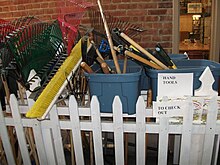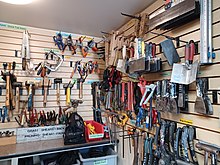Tool library


A tool library is an example of a library of things. Tool libraries allow patrons to check out or borrow tools, equipment and "how-to" instructional materials, functioning either as a rental shop, with a charge for borrowing the tools, or more commonly free of charge as a form of community sharing.[1] A tool library performs the following main tasks:
- Lending: all kinds of tools for use in at-home projects, residential maintenance and renovation projects, community improvement events, and weather event response.
- Advocacy: for the complete and timely return of all borrowed tools, to guarantee the long-term sustainability of available inventory. Staff also seeks compensation for lost tools and tools returned late.
- Maintenance: performing routine maintenance and repairs on all equipment to ensure good condition and to extend the lifespan of the inventory. This function is typically performed by volunteers and community service workers.
- Education: Some tool libraries also provide educational classes. Vancouver Tool Library and Community Access Center (VTLCAC) in Vancouver, Washington offers individual project support and classes on woodworking and basic car maintenance.[2]
- Sustainable Reuse Advocacy: tool libraries encourage shared access over individual ownership of tools. Tool libraries may host or support a repair café or education event to teach maintenance skills and extend the useful life of tool inventory.
History
[edit]The first known tool lending library was started by the Gross Pointe Rotary Club in Gross Pointe, Michigan in 1943.[3]
In the late 70s and early 80s, what could be considered the first generation of tool lending libraries got their start. In 1976 a tool lending library was started in Columbus, Ohio; originally run by the city, the tool library is now operated by ModCon Living, a non-profit organization that works to preserve and revitalize homes and communities in central Ohio. The ModCon Living Tool Library makes available over 4,500 tools free of charge to both individuals and non-profit organizations.[4] The Phinney Tool Library was started at the Phinney Neighborhood Association (PNA) in north central Seattle in 1978, and the Berkeley Tool Library was started in 1979 in Berkeley, California.[5] Many of these libraries were started with community block grants.[6]
A variation of the tool lending library model began in Atlanta, Georgia in 1992. At the Atlanta Community ToolBank (now ToolBank USA), the tools are reserved for use only by nonprofits and other community-based organizations who are performing volunteer and facility maintenance projects. The ToolBank tool inventory is not available to individuals.
In 2009, the community of West Seattle in Washington started the West Seattle Tool Library, which provides a wide variety of tools and resources for individuals and organizations while specifically encouraging sustainable urban living. In 2011, Popular Mechanics recognized "Building a Local Tool Library" as one of its top ten ways to change the world, while highlighting the West Seattle Tool Library.[7] In response to that recognition, a project called "Share Starter" was created that maps tool libraries worldwide and offers a free "Tool Library Starter Kit" to any community interested in starting a lending library of their own.[8] The kit includes start up guidelines, frequently asked questions, and sample documents. Additionally, the Center for a New American Dream published a webinar which highlighted insights from a handful of tool libraries on how to get started.
Spread
[edit]Given their increasing popularity and proven history of success, tool libraries and tool banks are now playing a role in the sharing economy and can be found in many local public libraries and makerspaces. Software platforms such as MyTurn[9] have been developed for managing tool and other types of lending libraries .[10]
Tool libraries also exist outside of the United States, with several in the UK, for example in Edinburgh,[11] Glasgow[12] and Liverpool,[13] and in Norway.[14][15][16][17] There also exist housing cooperatives with shared workshops, for example Kampen borettslag in Oslo.[18][19]
Equipment and facilities
[edit]Shared workspace
[edit]If a tool library chooses to host a shared workspace, some basic equipment can for example include worklighting, a workbench with vises, a woodworking bench, bicycle stand, bicycle pump, fire extinguishers, a vacuum cleaner, dustpans, brooms and a trash can.
Tools
[edit]The tool inventory is the most essential element of a tool library. Tools may be stored on shelves for members to access directly or behind a service counter for librarian access only. Tools must be numbered for cataloging, which is often done with lending software. What kind of tools a tool library should have varies with the community's needs.
- Durable tools that are useful for many situations as well as safety equipment are important.
- Specialized tools that are too expensive for many members to purchase individually or may only be used once or twice in a household are ideal for community lending. For example, a flooring installation kit may only be used once by a homeowner, but it can be reused by many different homeowners with shared access.
Many tool libraries accept donations of well-maintained tools to support their inventory. Inspection and testing is required to verify the functionality and safety of donated tools.
See also
[edit]References
[edit]- ^ O'Loughlin, Margie (September 5, 2016). "St. Paul Tool Library soon to open in Midway". Midway Como Monitor. Vol. 42, no. 3. p. 1.
- ^ "Events". Vancouver Tool Library and Community Access Center. Archived from the original on August 4, 2022. Retrieved August 3, 2022.
- ^ "Special Collections | Grosse Pointe Public Library". grossepointelibrary.org. Retrieved 2021-03-15.
- ^ Weiker, Jim (October 18, 2009). "Tool Library welcomes borrows in Columbus Archived 2011-03-27 at the Wayback Machine." The Columbus Dispatch.
- ^ Stellin, Susan (4 November 2004). "Library Science, Home Depot Style". New York Times. Retrieved 25 February 2021.
- ^ "Library Dispenses Tools and Home-Repair Advice". Berkeley Daily Planet. August 19, 2005.
- ^ DeMatto, Amanda (8 August 2011). "DIY Heroes: 10 Backyard Builders Changing the World". Popular Mechanics.
- ^ Dunn, Patrick (May 9, 2012). "How to Start a Tool Library". Shareable. Retrieved October 16, 2016.
- ^ "MyTurn Asset Tracking software". MyTurn.
{{cite web}}: CS1 maint: url-status (link) - ^ "The Chicago Tool Library". The Chicago Tool Library. Retrieved 2019-09-13.
- ^ "Edinburgh Tool Library - Edinburgh Tool Library". edinburghtoollibrary.org.uk. Retrieved 2021-12-09.
- ^ "Glasgow Tool Library - Glasgow Tool Library". 2020-03-10. Retrieved 2022-08-15.
- ^ "Liverpool Tool Library". liverpooltoollibrary.org.uk. Retrieved 2022-08-15.
- ^ "Verktøybibliotek - Deichman.no". deichman.no (in Norwegian). Retrieved 2023-07-10.
- ^ knut (2019-09-06). "Her låner du verktøy – gratis". Trondheim 2030 (in Norwegian Bokmål). Retrieved 2023-07-10.
- ^ Skille, Alf (2017-06-09). "Norges første verktøybibliotek". NRK (in Norwegian Bokmål). Retrieved 2023-07-10.
- ^ Bævre, Ann Iren. "Nå kan du låne to bøker og en borhammer på biblioteket". adressa.no (in Norwegian Bokmål). Retrieved 2023-07-10.
- ^ "Fryserom ble fellesverksted (Borettslaget Kampen) - Bolig & miljø 03, 2015 av OBOS BBL" (PDF).
- ^ "Bolig & miljø 03, 2015 by OBOS BBL - Issuu". issuu.com. 2016-03-09. Retrieved 2023-07-30.
